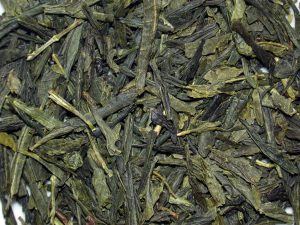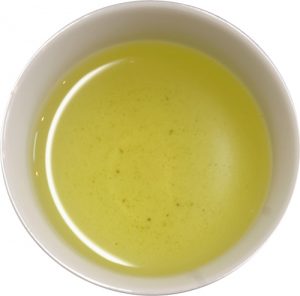Bancha (番茶, ordinary tea) is a Japanese green tea whose main characteristic is that it’s a lower grade than sencha.
tea whose main characteristic is that it’s a lower grade than sencha.
While the cultivation and processing are identical to sencha, there is a difference in the quality of the leaves used.
One way that bancha is made is when the leaves are sorted after the harvest.
The upper shoots of the green tea plant have a higher quality and thus are used for sencha, while the lower shoots have leaves that are courser and larger, hence they end up being bancha.
Another way that bancha is made is by harvesting the leaves at a later time, usually the third or fourth flush. The older the tea leaves, the less desirable they are.
The green tea leaves of the first harvest, shincha, make the highest quality tea for a given year.
Bancha vs sencha
For the average person, its difficult to distinguish between bancha and sencha. The difference that immediately stands out would be the price: bancha is always cheaper than sencha. In fact, houjicha and genmaicha are usually cheaper than sencha because they are often made with bancha.
Bancha has a lower caffeine content because older leaves have less caffeine, and as such is less bitter than sencha.
Upper tea shoots have more catechin (source of astringency, but also responsible in large part of the benefits of green tea) as compared to the lower (older) shoots. This means that bancha from a particular harvest has less catechin than sencha from the same harvest. Why? Because the lower leaves where being shielded from sunlight by the upper leaves, much like the cultivating process of gyokuro.
However, at later harvests, the catechin levels actually increase because of longer exposure to sunlight. Therefore, lower leaves from the second harvest will have about the same catechin content as upper leaves from the first harvest!
Sometimes you may see terms like ichibancha, nibancha, sanbancha and yonbancha. These refer to the time of harvest, but they are not types of bancha, although they sound the same. I will leave the topic of green tea harvests for another post.
How to brew bancha
Bancha is very easy to brew.  The method is the same as for genmaicha and houjicha.
The method is the same as for genmaicha and houjicha.
Use 3 to 4 grams per cup of bancha, and place it in the kyusu(Japanese tea pot: 急須). The following video shows a type of kyusu called dobin (土瓶). Use 120ml of boiling water per cup, pour it into the dobin, and let brew for 30 seconds.
Pour the bancha into each cup, alternating from cup to cup so that each cup gets an even mixture. The last drops are important, so pour until no more liquid comes out.

June 14, 2013
I am a big fan of japanese green tea! I have been drinking about 3 years now! My favourite is bancha. Nice info my friend keep it up!
June 14, 2013
Hi Rabbit thanks for the comment.
Bancha is a good everyday tea, you can’t go wrong by drinking it : )
April 23, 2014
I’v been drinking bancha for over 25 years now. My method of preparation is bring to boil in small saucepan then immediately turn down to lowest simmer, leave to simmer/brew for 10 to 15 minutes before pouring into cup/mug. It has more flavour this way. I’m totally addicted and drink several mugs a day.
April 23, 2014
Hi Chris
You’ve been brewing bancha for much longer than me 🙂
Your method of preparation sounds like a strong brew, it must have a lot of flavor.
April 26, 2015
A confirmed Tea drinker all my life! I have been mixing Australian Madura Tea & Bancha Tea & I do use milk (Haven’t been weaned yet) I realize it may not be as effective with milk but it is my way of at least getting some Green Tea effects Prior to using Bancha tea I used China Green tea with my method & my Blood Pressure normalized in a week! I hope that continues with Bancha tea
April 26, 2015
Hi Chris
Thank you for your comment.
Good luck with your tea mixture, I hope that you get the desired results.
July 28, 2015
Ricardo, please advise. What is the best on-line source of bancha, best price, best service. I suspect that this wonderful basic tea is often overpriced at the big tea houses. Would appreciate your help. -Brad
July 28, 2015
Hi Brad
Thanks for your question, although it’s not easy to answer.
Big tea houses often have blends, meaning that there is more than one region involved. It’s not always overpriced, sometimes it’s quite cheap. Some bancha even comes from China.
If you care about origin and year of harvest, I think that buying from a specialized tea shop would be best service. Also don’t forget to factor the shipping cost as well, especially when ordering from Japan. Sometimes you just have to buy more tea in the same shipment to justify that cost.
Bancha isn’t a high end tea, and different tea farms make bancha that tastes different. So just choose one whose flavor suits you and that the cost works for you as well.
January 12, 2016
Hi there,
I have been drinking the bancha for quite some time now.
I would dump the first infusion to remove the pesticide and some dust and I would drink the next one.
However though, after the first infusion, I would still be able to see the tea dust. Is it safe to drink that? Or should I keep it still until the dust sits at the bottom of the cup to avoid drinking the dust?
I don’t know what to do 🙁
January 13, 2016
Hi Edward
The dust that you refer to is just bits of the tea leaves that fall off. It’s safe to drink them.
Pesticide residue shouldn’t be much of an issue because it would also fall off during steaming and the like. Besides, tea farmers won’t apply pesticide right before harvesting, there are guidelines for that.
I guess it all depends on how much you trust your tea provider. But I wouldn’t dump the first infusion of any Japanese green tea.
January 14, 2016
Oh yes, I’ve read somewhere that the Japanese tea doesn’t really need that. But others you are advised to do so.
So it’s settled now, because I’ve been drinking the tiny leaves for quite some time now, and I don’t know whether it would do any harm for long run.
Thank heaps Ricardo!
August 12, 2018
Hello
will old harvest e.g 2016 will be fresh or no if so normally which harvest we should buy at the least.thanks
August 12, 2018
Hi Espi
Even an old harvest can still be fresh if it was kept in cold storage after processing and you haven’t opened the package yet. Once you open the package, it’s good for about 1 year.
The main reason to know the year of harvest would be to buy shincha, because you want the first tea from the year.
But for sencha and gyokuro, often year of harvest doesn’t matter much because it may have been aged in cold storage.
October 9, 2018
Hi Ricardo,
which cultivar is usually used to produce bancha?
October 9, 2018
Thanks for your comment.
The same ones used for other types of Japanese teas. Right now, the Yabukita cultivar makes up more than 70% of the cultivated area.
March 18, 2019
Thank you for all this information, it was very helpful for my essay for 7th grade humanities about different types of tea. 😀
March 18, 2019
Thank you for exploring the world of Japanese tea Melissa.
August 3, 2019
i just mix bancha with a bit of sugar, plus i leave the teaspoon in my cup. in summertime its great for iced tea. ive seen Chinese farmers do it that way. i call it matcha for the poor. adding jasmine teabag is great too!. variety is the spice of life!.
November 19, 2021
Great instructions. However, it would be helpful to mention the water temperature needed to brew Japanese tea. It’s supposed to be even slightly lower than that of Chinese green tea – around 75 degrees Celsius. Correct me if I’m wrong.
November 19, 2021
Hi Vincas
For higher grade Japanese green teas like sencha, kukicha, gyokuro, etc., you shouldn’t use boiling water.
But for teas like bancha, genmaicha and houjicha, you do need boiling water.
So the answer is that not all green teas are made at lower temperature water. It’s just that people generalize and group all green teas as if they were the same.
November 19, 2021
Ah, thanks for clarifying. Would you say it also depends on the method of brewing? I’ve seen mentions of a distinction between eastern and western styles of brewing. Western is the one that I described – lower temperature, lower volume of tea, and longer steeping times. Then the eastern one – more tea leaves, hot water, and very short steeping times. That allows for more re-steeping as well, and I’ve read that many people have traditionally used non-glazed teapots, which meant that it was used for only one kind of tea, because of its tendency to absorb the flavor.
November 19, 2021
While the Western and Eastern methods of brewing are different, even in Japan the temperature is lower for sencha (hot water but not boiling) than for bancha (boiling), for example.
It’s not that I invented these brewing parameters. They are the standard of the Nihoncha Instructor Association, which is pretty much the authority of Japanese tea in Japan.
October 26, 2022
I’m mostly a green tea drinker. I just love all the information you are sharing it is making my tea experience so much better. Thank you for that. Keep up the fantastic work. 👏😊
October 31, 2022
Hi Sharon
Thanks for reading the blog. I hope that your tea experience becomes even better.
December 20, 2023
Does bancha have good EGCG levels?
December 25, 2023
Hi Lindsey
If it’s fresh it should be higher EGCG content than a low quality green tea bag, but if you compare it to sencha then it is a little lower.